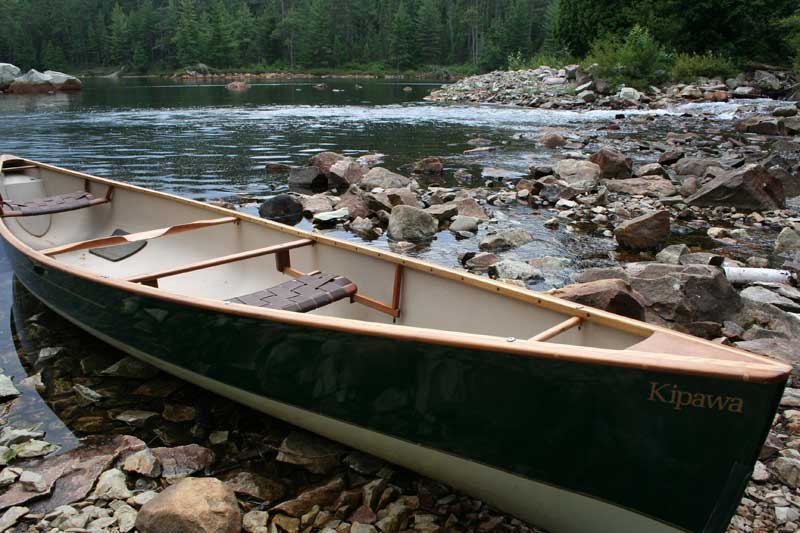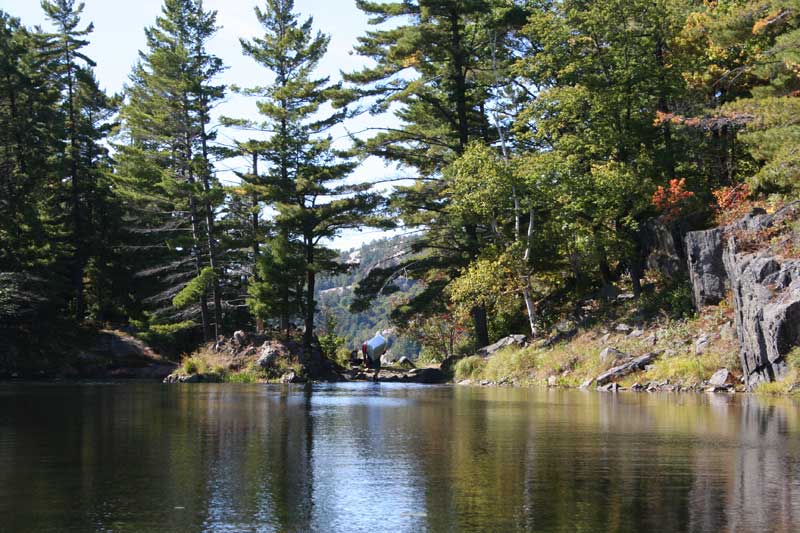
I don’t know anyone who really likes portaging; however portaging gives you options. Portaging means you get to see things you would never have access to otherwise. And portaging gets you further away from the crowds.
It really is all about attitude. I try to see it as a challenge/accomplishment and an adventure – OK – I said I try to see it this way – I am not always successful. I also see it as a way to burn some calories so I can open that tube of Pringles without guilt.
Getting to Shore
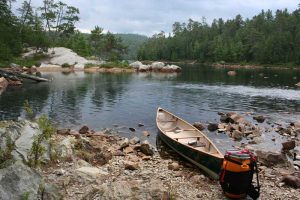
When you arrive at a portage you need to decide the best way to get to shore. If you are in the stern, it is best to tell your paddling partner your plan. Over the years I have noticed that couples seem to have a hard time with this. An even a better idea; take a minute to discuss your plan together first. I know, crazy eh?!
Do we come in to the portage fast and try to get up onto shore or do we need to paddle in slowly, looking for rocks and logs? Do we come in horizontal or vertical to the shore? Is it deep or shallow, rocky or sandy or is it the dreaded smelly MUCK? Who jumps out first? In a group do you all try to get to shore or does it need to be one at a time? What method will have the least impact on the shoreline, plants and creatures that live there.
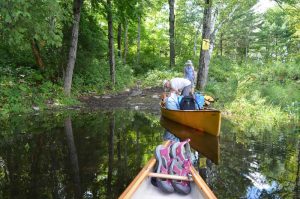
I recommend water shoes. We wore Teva’s for years and loved them but getting sticks in the toes became a problem. We have all become Keen sandal advocates – the heavy duty, thick toe variety. You can get them wet and still wear them on the portage – no need to stop to change shoes, unless the portage is particularly rugged and you need hiking shoes. I find stopping on the portage to put on hiking shoes stressful, it feels like I am holding people up or getting in the way of others. I love jumping out of the canoe and just going.
We once saw a young man portaging on a very rocky portage wearing flip-flops. Not a good idea (according to us old, seasoned paddlers). You need something sturdy on your feet and a sole with some grip.
Jumping out of the canoe with bare feet is definitely not a good idea because of sharp rocks.

After one canoe trip to Clear Lake, I did some research to learn more about snapping turtles – we saw so many on that trip. Once I learned that snapping turtles like to bury themselves in the muck, I have one more reason to be careful jumping out of the canoe in bare feet. I am sure it rarely happens, but the idea of stepping on a turtle while getting in or out of the canoe is something I never want to experience. I am sure turtles don’t like it either.
BTW – please don’t feed the turtles. Also please clean your fish away from the swimming areas; actually for that matter, clean fish far away from the campsite. No need to attract turtles or bears. Avoid washing dishes in the lake too please – for many reasons, attracting turtles being just one.
Loading and Unloading
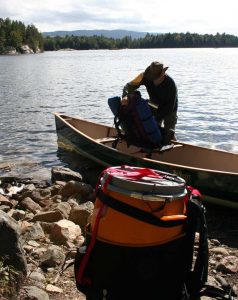
The next decision is how to unload. Do you have one person bringing things from the canoe to shore and the other person taking things off to the side of the trail or do you both unload? Or does someone hold the canoe steady? Does everyone grab their stuff and just start across the portage?
This is a good place to mention that it is important to take your canoe out of the water, so you are not blocking the way of others. If you leave your canoe in the water at either end, no one else can arrive or leave easily.
Also, if you need a break, try to stay to the side of the portage. If you can, avoid having lunch or a family swim at a portage – as tempting as this might be. You want to avoid blocking everyone else from coming and going. After you launch, you can start looking for a nice place for lunch and a swim.
You will soon get a system for loading as well. You want to load your canoe so the weight is well balanced. Leave yourself some leg room, especially if you are going to be in the canoe a long time. Try to keep things below the gunwales too.
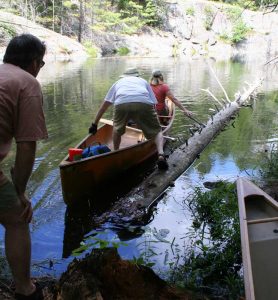
Getting in and out of a canoe can be tricky if it is rocky, steep, muddy, narrow, windy, busy, hot, buggy, …. OK that made it sound worse than it really is. It isn’t so bad…really. In fact it can be fun.
Some portages will have docks, because it is too difficult to get in and out without damaging the wetland. I appreciate this, but it is challenging. Check out this How to Launch and Land article on the Cottage Life website.
In addition to portages, it is nice to have a campsite that has a good spot for loading and unloading. Little beach areas are nice. Sheltered areas are also good.
Sometimes, you just need someone to steady the canoe until you get in or out. If you are in the canoe you can steady it for the person getting in by keeping your paddle in the water. If it is deep, move your paddle back and forth on the surface. As you know, you can’t steady a canoe with your hands on the gunwales.
Avoiding Busy Times

We have been at a portage where there were 5 canoes floating around waiting for their turn to land and unload. Another time, while leaving a portage, we saw about 20 canoes coming toward us – we were so lucky that we missed that hectic experience.
We make an effort to avoid busy portage times by starting and ending our trips on a Monday. During the trip we try to schedule our travel on weekdays, which means getting to a site on Friday and staying until Monday.
Portages are busy Friday afternoons and evenings and Sunday starting about noon. If you can, plan your portages to avoid these busy times. It will save you time and it will be more relaxing.
The Portage
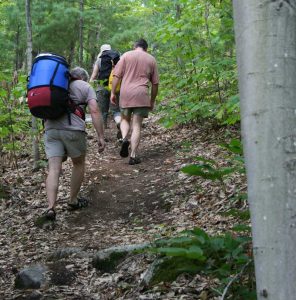
We have had people we meet at a portage offer to take things across for us because they are heading back empty-handed. (Maybe it’s because we look old.) This is such a nice offer, however, we always say no because we have a system. It also feels wrong, having someone carry your stuff.
When you arrive at the other side of the portage, you want to put your things off to the side of the trail and keep your stuff all together. This reduces the likelihood of things getting mixed up with “other people’s stuff”.
What do you take across first? Some people can carry a canoe and a pack and do it all in one trip. Because we need to do the portage twice, we take the canoe one trip and packs and barrels the next. Since the canoe needs to be taken out of the water to make room for others arriving, it make sense to keep going right across the portage since you are picking it up anyway; however, it is harder to see where you are going with a canoe on your head. Sometimes it’s worth leaving the canoe off to the side at the takeout and taking it across last. For example, trees overhead can stop you up quick. Another option is to have someone with a pack walk ahead of you.
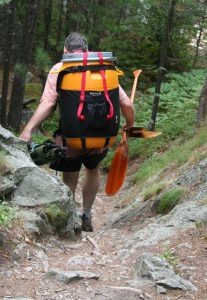
One of the things that can be hard to carry across a portage are paddles – try managing three in one hand. We have made Velcro straps so we can attach the paddles to the canoe. A trick learned from our brother-in-law. It is so much nicer.
I have a friend who paddles with a group of women every year and they have one solid rule, “no loose frufru in the canoe”. That is what they call the little stuff that slows people down at a portage. Water bottles, sunscreen, hats, maps, GPS, snacks, shoes, all kicking around loose in the canoe. Their rule – everything needs to be in or attached to a pack. Loose stuff can get left behind too. We have been lucky over the years and hiking shoes have been the only thing left behind at a portage.
My goal last year was to spend some time at the gym so I would be able to pick up my own pack. I was getting frustrated waiting for someone to help put the pack on my back at the portage. I was successful! Although I still prefer the help from a paddling partner. Setting the pack on a large rock will also do.
Portages are always fun for meeting interesting people. Once, we met someone portaging with a suitcase on wheels. Whatever works!. Note: a good backpack will make life easier. I am always amazed at the number of people we meet carrying coolers on a portage. I could not do that!
We often learn from people we meet on portages. We learned about making sprouts from a couple we were talking to on a portage.
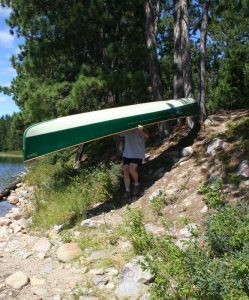
We once met a group portaging and one of their group members had an oxygen mask and tank. Where there is a will there is a way. Such an inspiration.
Normally, solo carrying a canoe is the easiest, especially if you have a good yoke and a well balanced canoe. Never have stuff dangling off your canoe. We’ve seen people with their safety kit swinging from the canoe on a portage. Even something little like that will make the canoe impossible to carry.
Although some people like to carry the canoe with another person (especially if it is a heavy canoe) this is actually harder, you can’t see where you are going and you need pretty good communication. We once saw two people pick up a canoe together and they were facing in opposite directions. The image still makes us giggle.
At the end of a particularly challenging portage at Vicary Lake – my brother-in-law set down his 80 lbs canoe (with the terrible yoke) and declared the trip the last one for the “beast”. The following year he had a very light solo canoe.
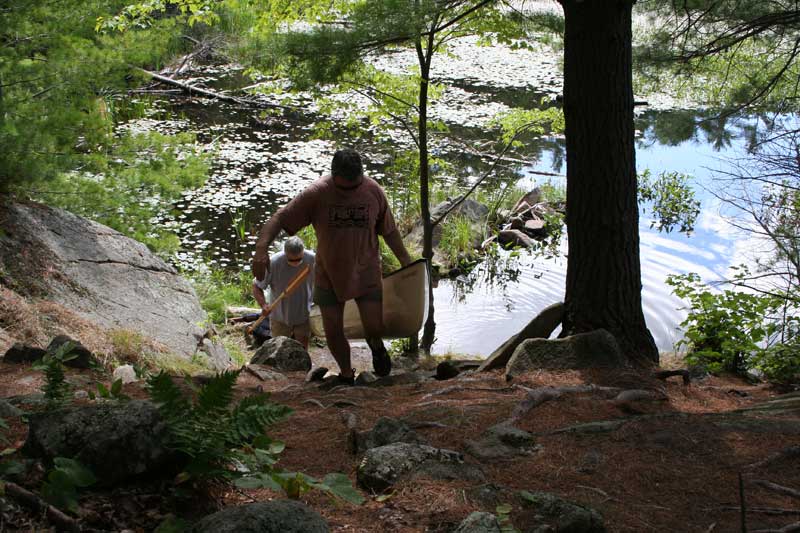
If you reach a steep spot, hand-over-hand with a partner works. Sometimes all you need is a hand getting the canoe to a place where it is easier to pick up.
Safety First
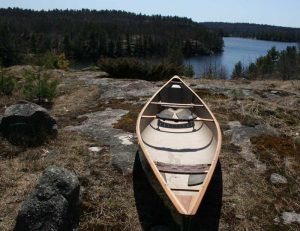
We saw someone carrying a canoe dragging about 10 feet of rope. Just imagine if it got caught on a rock or someone stepped on it. OUCH!
Portages are where injuries can happen. Watch your step – roots and slippery rocks can be a nightmare. Twisty portages are hard with canoes, as well as low hanging branches and steep declines.
Someone in our group was carrying a pack and a canoe when they tripped on a root during a trip to Killarney. The pack got stuck on the yoke when he fell. Lucky the only damage was a broken gunnel and it was on our way home. On the same trip another person in our group slipped on a steep downhill and fell onto one knee with a canoe on his head. Lucky a skinned shin was the only injury.
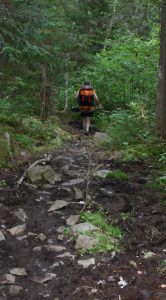
We have had two people injured on the portage into Frog Pond between Spider and Clear Lakes. It is a short but steep portage that is often slippery with lots of roots.
We heard a story of a kid running ahead on a portage into Muriel Lake in Killarney, only to encounter a mother bear and her cubs. It all worked out OK, but it was pretty scary.
One of our group members (from our early camping days) was alone on the portage and thought she was being followed by a bear. She kept hearing things thump behind her. Turns out, her pack was open and things were falling out. Although this happened many years ago, it’s a story that comes up on every trip.
One of my most frightening experiences was on a portage from Spider lake to Three Legged Lake. There was a storm following us up Spider Lake to the portage.
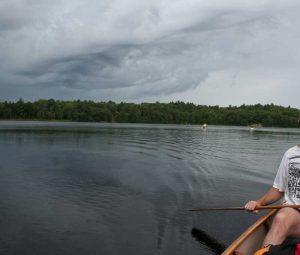
So what is the best option? We were trying to decide what the best option was – sit on shore or just start walking the portage. Since we were not safe with either choice we started moving. I was alone when a bolt of lightening hit, just to my left, on the way up a hill. It was so close and loud I heard people behind me screaming.
I still don’t know what the right thing to do is. No matter how you slice it, you are under trees, in a storm, with no shelter. One advantage of walking is that the group isn’t all together in one place. However, I think next time, I may just find a low spot to wait it out.
Being on a portage is better than being on the lake. Another good reason to be able to check the weather reports before starting out.
Portage Etiquette
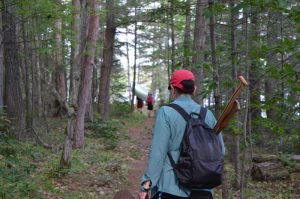
Through trial and painful error we learned a lot and we have met some lovely people on the way.
However, we have met a few people who were not aware of some basic portage etiquette. My little summary:
- Unload quickly and move all your things off to the side of the portage
- On the other side of the portage, put all your things off to the side – including your canoe. (If you put your canoe in the water no one else can come or go)
- Avoid hanging out at the portage for lunch or a family swim, it does block the way of others
- If you meet someone on the portage, and you don’t have any stuff, move out of the way of the person with gear
- People with canoes on their head, always have the right-of-away
- If you are going to stop to rest, look around, pick berries or admire the view, or just use the portage for a day hike, make sure you are well off to the side so people can get past
- Please keep your dog on a leash
OH MY I do sound old.
See the Beauty
I would rather be on the lake than on a portage, but portages can be beautiful. Lift-overs can be fun.
Plan ahead because some trips will seem like they have more portaging than paddling. Plan your route based on the skills and abilities of your group. There is no shame in going in and out the same route.
